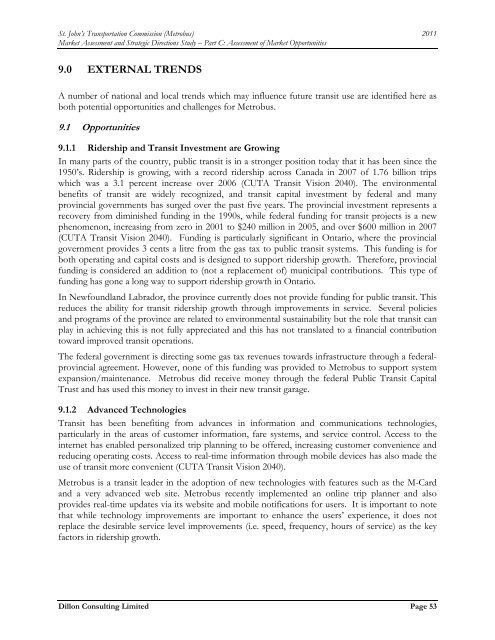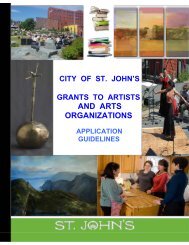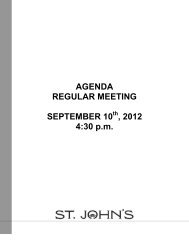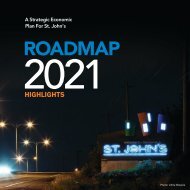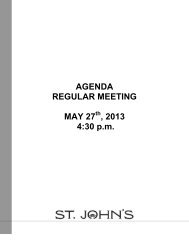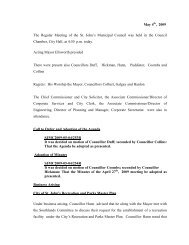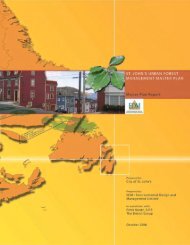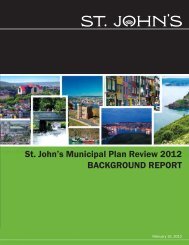Metrobus Transit Study.pdf - City of St. John's
Metrobus Transit Study.pdf - City of St. John's
Metrobus Transit Study.pdf - City of St. John's
You also want an ePaper? Increase the reach of your titles
YUMPU automatically turns print PDFs into web optimized ePapers that Google loves.
<strong>St</strong>. John’s Transportation Commission (<strong>Metrobus</strong>) 2011<br />
Market Assessment and <strong>St</strong>rategic Directions <strong><strong>St</strong>udy</strong> – Part C: Assessment <strong>of</strong> Market Opportunities<br />
9.0 EXTERNAL TRENDS<br />
A number <strong>of</strong> national and local trends which may influence future transit use are identified here as<br />
both potential opportunities and challenges for <strong>Metrobus</strong>.<br />
9.1 Opportunities<br />
9.1.1 Ridership and <strong>Transit</strong> Investment are Growing<br />
In many parts <strong>of</strong> the country, public transit is in a stronger position today that it has been since the<br />
1950’s. Ridership is growing, with a record ridership across Canada in 2007 <strong>of</strong> 1.76 billion trips<br />
which was a 3.1 percent increase over 2006 (CUTA <strong>Transit</strong> Vision 2040). The environmental<br />
benefits <strong>of</strong> transit are widely recognized, and transit capital investment by federal and many<br />
provincial governments has surged over the past five years. The provincial investment represents a<br />
recovery from diminished funding in the 1990s, while federal funding for transit projects is a new<br />
phenomenon, increasing from zero in 2001 to $240 million in 2005, and over $600 million in 2007<br />
(CUTA <strong>Transit</strong> Vision 2040). Funding is particularly significant in Ontario, where the provincial<br />
government provides 3 cents a litre from the gas tax to public transit systems. This funding is for<br />
both operating and capital costs and is designed to support ridership growth. Therefore, provincial<br />
funding is considered an addition to (not a replacement <strong>of</strong>) municipal contributions. This type <strong>of</strong><br />
funding has gone a long way to support ridership growth in Ontario.<br />
In Newfoundland Labrador, the province currently does not provide funding for public transit. This<br />
reduces the ability for transit ridership growth through improvements in service. Several policies<br />
and programs <strong>of</strong> the province are related to environmental sustainability but the role that transit can<br />
play in achieving this is not fully appreciated and this has not translated to a financial contribution<br />
toward improved transit operations.<br />
The federal government is directing some gas tax revenues towards infrastructure through a federalprovincial<br />
agreement. However, none <strong>of</strong> this funding was provided to <strong>Metrobus</strong> to support system<br />
expansion/maintenance. <strong>Metrobus</strong> did receive money through the federal Public <strong>Transit</strong> Capital<br />
Trust and has used this money to invest in their new transit garage.<br />
9.1.2 Advanced Technologies<br />
<strong>Transit</strong> has been benefiting from advances in information and communications technologies,<br />
particularly in the areas <strong>of</strong> customer information, fare systems, and service control. Access to the<br />
internet has enabled personalized trip planning to be <strong>of</strong>fered, increasing customer convenience and<br />
reducing operating costs. Access to real-time information through mobile devices has also made the<br />
use <strong>of</strong> transit more convenient (CUTA <strong>Transit</strong> Vision 2040).<br />
<strong>Metrobus</strong> is a transit leader in the adoption <strong>of</strong> new technologies with features such as the M-Card<br />
and a very advanced web site. <strong>Metrobus</strong> recently implemented an online trip planner and also<br />
provides real-time updates via its website and mobile notifications for users. It is important to note<br />
that while technology improvements are important to enhance the users’ experience, it does not<br />
replace the desirable service level improvements (i.e. speed, frequency, hours <strong>of</strong> service) as the key<br />
factors in ridership growth.<br />
Dillon Consulting Limited Page 53


